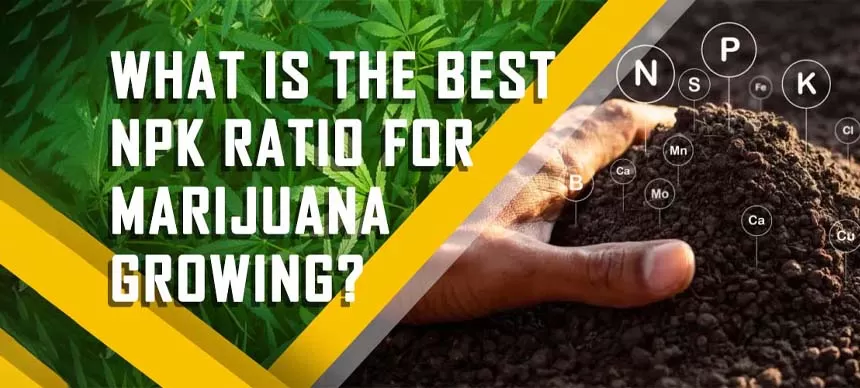Table of Contents
ToggleCultivating cannabis is a rewarding endeavor that demands attention to detail at every stage of the plant’s lifecycle. The cannabis fertilizer ratio, which represents the balance of three vital macronutrients – Nitrogen (N), Phosphorus (P), and Potassium (K) – plays a pivotal role in cannabis cultivation. We will delve deeper into the world of NPK ratios and their significance in the successful growth of cannabis. Whether you’re a novice or an experienced cultivator, understanding the intricacies of NPK ratios will help you maximize the quality and quantity of your cannabis harvest.
Understanding NPK
NPK stands for Nitrogen (N), Phosphorus (P), and Potassium (K), the three essential macronutrients that plants need in relatively large quantities to thrive. These macronutrients serve distinct roles in cannabis growth and development. Nitrogen is responsible for fueling vegetative growth. It is a key component of chlorophyll, the green pigment essential for photosynthesis, and is instrumental in the production of amino acids, proteins, and nucleic acids. Without sufficient nitrogen, cannabis plants would struggle to establish healthy foliage.
The Role of Nitrogen N, P, and K
Nitrogen (N)
Nitrogen is the engine behind the lush green leaves that cannabis enthusiasts covet. During the vegetative stage, when the plant is focusing on leaf and stem growth, nitrogen takes center stage. Adequate nitrogen levels ensure that your cannabis plants develop robust branches and leaves, setting the stage for a bountiful harvest during the flowering phase.
Phosphorus (P)
Phosphorus is the nutrient that powers root development and flowering in cannabis plants. As your cannabis plants transition into the flowering stage, they require an ample supply of phosphorus to produce the vibrant, resin-covered buds that are the hallmark of a successful harvest. Phosphorus is essential for energy transfer within the plant and plays a crucial role in DNA and RNA synthesis, making it indispensable for the overall health and vitality of your cannabis crop.
Potassium (K)
Potassium, often referred to as the “quality nutrient” for cannabis, contributes to overall plant health and resilience. It functions as an activator for numerous enzymes and is critical for the efficient use of water and the regulation of carbon dioxide in plant cells. Adequate potassium levels result in sturdier stems, improved drought tolerance, and enhanced resistance to pests and diseases. It is safe to say that potassium is the guardian of your cannabis plants, fortifying their defenses and ensuring they reach their full potential.
Finding the Ideal NPK Ratio
The quest for the perfect best NPK for cannabis can be likened to finding the ideal recipe for a gourmet meal. The ideal ratio depends on the specific growth stage of your cannabis plants and the cultivation method you employ. During the vegetative stage, a balanced NPK ratio such as 10-10-10 or 20-20-20 can work wonders. This ratio provides a uniform supply of all three macronutrients, fostering lush foliage and robust branches.
However, when your cannabis plants transition to the flowering stage, they have different nutritional requirements. This is where you should consider ratios with higher phosphorus and potassium levels, such as 5-10-10 or 10-20-20. These ratios support the development of those coveted buds. Remember, finding the ideal npk for cannabis may require some experimentation based on your unique growing conditions and the specific strains you’re cultivating.
NPK Ratio for Different Growth Stages
Understanding how to adjust the marijuana fertilizer ratio according to the growth stage of your cannabis plants is essential for optimal cultivation. Let’s break down the NPK requirements for each phase:
- Seedling Stage: During this initial stage, cannabis plants are focused on developing a strong root system and establishing themselves. A higher nitrogen ratio, such as 2-1-1, can provide the necessary boost for rapid vegetative growth. At this point, the plants are not yet ready for flowering, so a higher nitrogen concentration aids in developing sturdy seedlings.
- Vegetative Stage: Once your cannabis plants have established themselves, it’s time to promote healthy foliage and stem development. Balanced NPK ratios like 10-10-10 or 20-20-20 work well during this stage. These ratios provide a steady supply of nitrogen, phosphorus, and potassium, ensuring that your plants grow vigorously and develop a robust structure.
- Flowering Stage: As your cannabis plants transition into the flowering stage, they require a different NPK balance. A ratio like 5-10-10 or 10-20-20, with higher phosphorus and potassium levels, encourages the development of large, resinous buds. Phosphorus is essential for bud formation, and potassium helps in bud filling and overall plant health. This shift in NPK ratios is crucial for achieving a successful harvest.
Organic vs. Synthetic Fertilizers
When it comes to selecting the right fertilizers for your cannabis plants, you have two main options: organic and synthetic. Each has its advantages and considerations.
- Organic Fertilizers: These fertilizers are derived from natural sources and release nutrients slowly over time. They promote soil health and microbial activity, enhancing the overall vitality of your cannabis plants. Organic fertilizers are a popular choice for growers who prioritize sustainability and the long-term well-being of their soil. Examples of organic fertilizers include compost, bone meal, and fish emulsion.
- Synthetic Fertilizers: Synthetic or chemical fertilizers provide a quick and precise nutrient boost to your cannabis plants. They are formulated to deliver nutrients in a readily available form, ensuring rapid absorption by the plants. This can be particularly useful when you need to address nutrient deficiencies quickly. However, synthetic fertilizers do not contribute to soil health in the same way organic fertilizers do, and overuse can lead to salt buildup in the soil.
The choice between organic and synthetic fertilizers ultimately depends on your cultivation goals and values. Many growers opt for a hybrid approach, combining both types to benefit from the strengths of each.
Adjusting NPK for Soil and Hydroponics
The growing medium you choose significantly impacts the weed NPK requirements of your cannabis plants. Here’s how you can adapt NPK ratios for different cultivation methods:
- Soil-Based Cultivation: If you’re growing cannabis in soil, organic fertilizers are often a good fit. The organic matter in soil helps buffer nutrient delivery, making it less likely to cause nutrient imbalances. Adjust your NPK ratios according to the specific needs of your soil, which can vary depending on its composition and pH levels. Regularly testing the soil and maintaining the appropriate pH range is crucial for nutrient uptake.
- Hydroponic Systems: Hydroponic cultivation offers precise control over nutrient delivery but demands meticulous attention to NPK ratios. Hydroponic systems require a different set of fertilizers designed for hydroponics. Follow the manufacturer’s guidelines carefully and monitor your plants closely, as hydroponics can be less forgiving of nutrient imbalances compared to soil cultivation.
Understanding the characteristics of your growing medium and selecting the right fertilizers and npk for cannabis ratios accordingly will ensure that your cannabis plants receive the nutrients they need for optimal growth and development.
Common NPK Mistakes to Avoid
Avoiding common NPK mistakes is essential for the health and productivity of your cannabis plants. Here are some pitfalls to watch out for:
- Overfeeding: Applying too much fertilizer can lead to nutrient imbalances and damage your plants. Always follow recommended dosage guidelines and monitor your plants for signs of overfeeding.
- Underfeeding: On the flip side, not providing enough nutrients can stunt growth and reduce yields. Pay attention to your plants’ nutritional needs and adjust the cannabis fertilizer ratio accordingly.
- Ignoring pH Levels: pH levels in your growing medium play a critical role in nutrient absorption. Ensure that your pH levels are within the appropriate range for your chosen NPK ratio to facilitate optimal nutrient uptake.
- Using the Wrong Ratios: Using an improper marijuana fertilizer ratio for the growth stage can hinder cannabis growth. Always tailor your NPK ratios to the specific needs of your plants at each stage of growth.
Monitoring and Adjusting NPK Over Time
Successful cannabis cultivation requires continuous monitoring and adjustment of NPK ratios. Regularly inspect your plants for any signs of nutrient deficiencies or excesses, such as leaf discoloration, yellowing, or stunted growth. These symptoms can be indicators that your NPK ratio needs modification.
Keep a grow journal to track your cannabis plants’ progress and the nutrient levels you’ve been providing. This record-keeping will help you identify trends and make informed adjustments as needed. Remember that cannabis cultivation is a dynamic process, and being attuned to your plants’ changing requirements is key to achieving a successful harvest.
Conclusion
In conclusion, the best NPK ratio for cannabis growing is not a one-size-fits-all solution but rather a dynamic and adaptable approach that considers the specific growth stage, cultivation method, and unique characteristics of your cannabis plants. By understanding the roles of nitrogen, phosphorus, and potassium, and how to adjust their ratios throughout the cannabis lifecycle, you can nurture healthy, vibrant plants and enjoy a bountiful harvest.
Frequently Asked Questions (FAQs)
1. What is the best NPK ratio for cannabis?
The best NPK ratio for cannabis depends on the growth stage. During the vegetative stage, a balanced ratio like 10-10-10 or 20-20-20 works well. For flowering, switch to a ratio with higher phosphorus and potassium, such as 5-10-10 or 10-20-20.
2. Can I use organic fertilizers for cannabis?
Yes, you can use organic fertilizers for cannabis. They provide nutrients gradually and improve soil health. Organic options are a popular choice for growers aiming for sustainability and soil enrichment.
3. How do I adjust NPK ratios for hydroponic systems?
In hydroponic systems, you may need to adjust NPK ratios compared to soil cultivation. Hydroponics requires precise nutrient control, so follow the manufacturer’s guidelines and monitor your plants closely.
4. What happens if I use the wrong NPK ratio?
Using the wrong NPK ratio can lead to nutrient imbalances, stunted growth, and reduced yields. It’s crucial to match the ratio to the growth stage and monitor your plants for signs of nutrient deficiencies or excesses.
5. Why is potassium (K) essential for cannabis?
Potassium is vital for cannabis because it enhances overall plant health, strengthens stems, improves drought resistance, and boosts resistance to pests and diseases. It’s often called the “quality nutrient” for cannabis.















